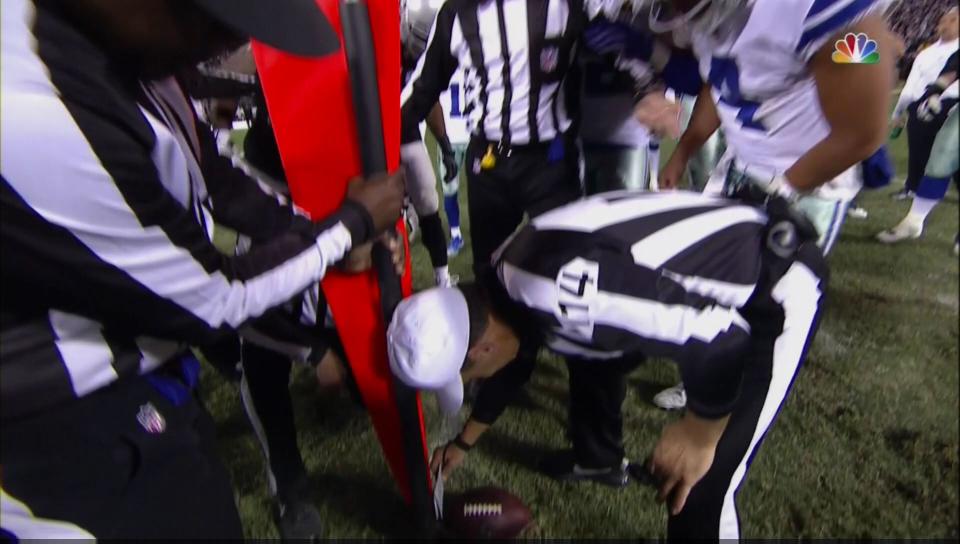Tracking chips inside footballs could phase out the need for an index card
No offense to the chain gang, but wouldn’t it be nice if technology allowed NFL officials, players, coaches and fans to have a better idea of how much a team has advanced the football on a crucial third-down or goal-line play?
Well, that technology exists. And it’s already in the football.
Last weekend’s creative, hilarious and slightly preposterous use of an index card to measure for a first down late in the Raiders vs. Cowboys game gave rise to questions about whether there is a better way. The chain gang is as traditional as football itself, but it risks inaccuracy.
In an era in which technology exists to freeze a Target shopping cart the moment it gets too far from the store, can’t we help the refs a little more with first-down measurements?
The answer is yes.
For the first time, Zebra Technologies has implanted an “RFID” chip inside every NFL football, right under the league logo.
“We are spotting [the football] throughout the entire game,” says John Pollard, Zebra’s vice president of business development.
Here’s how it works: RFID stands for radio frequency identification, and an RFID chip sends out electromagnetic waves to a nearby antenna. A reader converts waves into digital data. The chip in the football “blinks,” or transmits, 25 times a second. There are receivers in every stadium, in the pylons and elsewhere on the field.
Here’s the catch: the technology is only accurate to within six inches. Crucial down and distance measurements are narrower than that. However, Pollard says the technology can be improved.

“If our partner wanted to work towards a level of precision inside of six inches,” Pollard says, “we would consider it. It’s certainly feasible.”
The NFL has partnered with Zebra for years, and already has players tagged with chips. That’s how we learn how fast someone is running during a play, for example. But league spokesman Brian McCarthy says the chips are “not designed for officiating use.”
“For a number of years we have considered various potential first-down measurement technologies,” McCarthy wrote in an email to Yahoo Sports, “but have not found one to date that we were comfortable with to deploy.”
While the chips are currently not specific enough to rely on over the human eye, it would seem the technology could assist the human eye. Information about the ball’s progress is available almost instantaneously, so it could be consulted in a pinch. Consider, for example, a goal-line scrum in which a quarterback disappears into a mob of defenders. In those instances it can be difficult for anyone to see exactly where the ball is.
“It may seem to us as fans that when we have a couple interesting in-game experiences, we wonder: Why isn’t the tech utilized?” Pollard says. “These things are being considered and studied.”
Eventually, the technology will be more specific, but that will give rise to another dilemma: How should we measure the progress of the football? Up until now, it’s the nose of the football that counts. The index card measurement last Sunday was based on the very front tip of the ball. If RFID technology is used for officiating, that would mean making the center of the ball all-important – since that’s where the chip is embedded.
For now, it’s the tip of the football, and the league has instructed officials no longer to use an index card for measurement purposes. Gene Steratore, the longtime official who had the card ready, insisted it was only to “reaffirm” a decision that was already made.
Maybe someday soon an RFID chip will also be used to “reaffirm” the calls of the experts on the field. For now, football and technology are both a game of inches.

